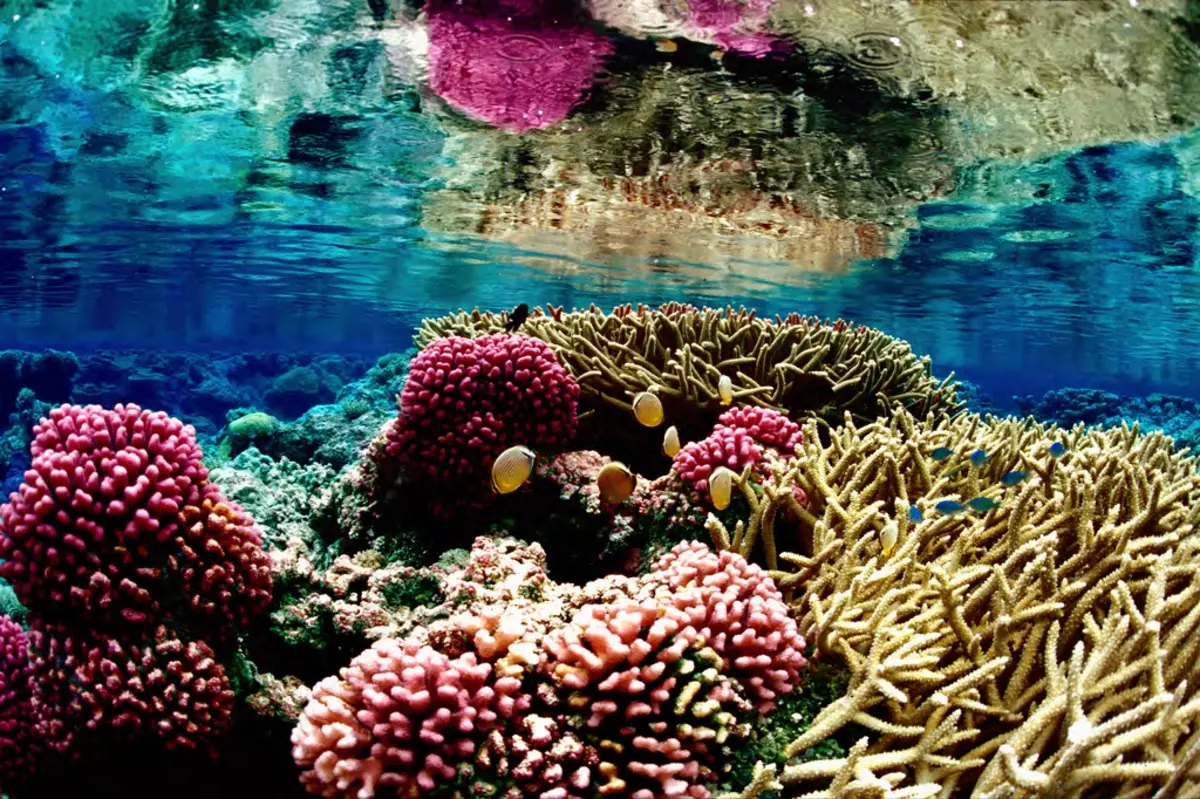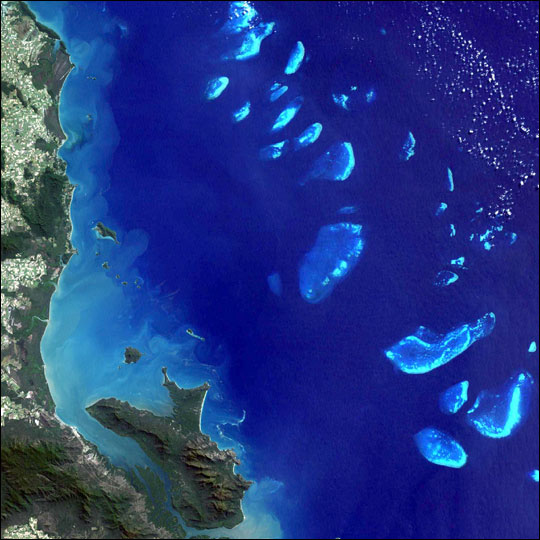
© Maragos, Jim/USFWS
Exploring beneath the ocean a world of vibrant coral reefs, woven with wisdom that speaks of a Creator.
Musa Sattar, London, UK – Deputy Science Editor
Beneath the shimmering surface of the ocean, hidden like a secret city of breathtaking beauty, lies one of nature’s most extraordinary wonders: the coral reef. A place of dazzling colours, teeming with life, where delicate structures rise from the ocean floor in an exquisite display of balance and harmony. It is an underwater masterpiece, an ecosystem so perfect in its design that it humbles even the most experienced scientists. Every inch of this living structure tells a story, a tale of creation and purpose, woven together by unseen hands that have shaped the universe with meticulous care.
The reef is not merely a collection of lifeless rocks; it is alive. Though they resemble underwater gardens, corals are not plants but tiny animals known as polyps; some no larger than a pinhead, others growing as big as a basketball. Coral creates a structure composed of multiple polyps embedded in a common body. Each polyp has a soft, saclike body crowned with stinging tentacles, and to protect itself, it extracts calcium carbonate from seawater and builds a limestone fortress around itself, forming the hard skeleton that makes up the reef. These tiny architects worked together over thousands of years, constructing sprawling cities beneath the waves.
The Great Barrier Reef, stretching over 2,300 kilometres, is the largest structure ever built by extremely delicate living organisms, so vast it can be seen from space. As one of the Seven Wonders of the Natural World, it stands as a silent testament to a force beyond mere chance, a force of precision and wisdom that governs all things.
Every coral structure begins with the tiny, seemingly random choices of individual polyps. A single polyp might grow upward, downward, or sideways, cloning itself in different directions. Yet, when viewed as a whole, these tiny actions come together in perfect harmony, forming intricate sheets, branching tendrils, or towering coral structures that seem almost deliberately designed.
Amazingly, the coral reef is not just a static marvel. It is a world bustling with life. Despite covering less than 1% of the ocean floor, it is a habitat that shelters nearly 25% of all marine species. It is a rich ecosystem that nurtures a vast array of life. Some estimates suggest up to two million species thrive within their intricate labyrinths, making them as biodiverse as tropical rainforests. Every nook and cranny teems with movement, graceful sea turtles glide through its waters, bright fish dart in and out of coral crevices, and octopuses shift colours like living illusions. Even the tiniest of creatures play an essential role. Cleaner shrimp diligently groom fish, removing parasites as part of an unspoken agreement; one of many symbiotic relationships that weave together this living fabric. Here, everything functions in perfect harmony; even the smallest disruption can send ripples through the entire ecosystem.
Beyond its role as a sanctuary for marine life, the coral reef serves as a shield, protecting coastlines from the fury of the ocean. These structures absorb wave energy, reducing the impact of storms and preventing erosion that could devastate human settlements. Without them, countless coastal communities would face the unrelenting power of the sea.
Hazrat Mirza Bashiruddin Mahmud Ahmad (ra), the Second Worldwide Head of the Ahmadiyya Muslim Community, beautifully reflected on this phenomenon, marvelling at how entire islands are formed by the relentless efforts of tiny creatures; creatures so small that they often go unnoticed, yet their collective work gives rise to landmasses that sustain human life.

© NASA
Stretching more than 2,000 km (1,200 miles) along the Queensland coast, the Great Barrier Reef was inscribed on the World Heritage List in October 1981.
He said, ‘I have always been amazed when thinking about coral reefs. It has been discovered that some islands are not made of real soil but are instead formed from coral reefs. These islands are created by the collective effort of tiny creatures, so small that they are barely noticeable, yet today, they host human settlements. What are these islands? They are pieces of land [called atolls] that stand against the vast ocean, carrying humanity on their backs. These islands exist as a result of the work of countless tiny creatures. In other words, the land that its inhabitants call their homeland is nothing but the outcome of these small, seemingly insignificant creatures relentlessly sacrificing their lives. One after another, these creatures perish, and in their millions, they continue to die, forming the very ground upon which human beings – created by God for the manifestation of His power and glory – eventually reside. Can it then be said that even these tiny creatures have a role in this divine expression of majesty? Indeed, the first creature that died and sank to the bottom of the sea played a part, though the common inhabitants of the island may not recognise its contribution. However, there is no doubt that it had a role to play. Had that creature not given its life, and had others not continued to die upon one another in the same manner, no human being could have ever settled on that land which had formed, and their Creator would not have manifested His glory there.’
But their importance does not end there. Coral reefs contribute to the livelihoods of millions of people worldwide, supporting fishing industries, tourism, and even medicine. Scientists have discovered compounds within reef organisms that hold the potential to treat cancer, arthritis, and bacterial infections. For example, research in 2024 demonstrated that coral extracts can significantly suppress tumor growth and prevent the spread of prostate cancer cells, offering new hope for sustainable anticancer drug development. Similarly, in 2022, researchers at the University of Utah discovered that soft corals off the Florida coast produce eleutherobin, a powerful anti-cancer compound. By decoding the coral’s genetic blueprint for this chemical, they paved the way for large-scale production, bringing it one step closer to medical application.
But then again, the healing potential of corals doesn’t stop there. Compounds derived from the soft coral Sarcophyton trocheliophorum, such as sarcotrocheliol and cholesterol, have been found to trigger apoptosis – the programmed death of cancer cells – in human colorectal and liver cancer lines. These same compounds also exhibit antimicrobial and insecticidal properties, expanding their pharmaceutical potential. A 2024 study further highlighted marine-derived anticancer agents, including those from soft corals like Sinularia flexibilis, which show promising activity against leukemia and other aggressive cancers.
With each new discovery, coral reefs prove to be more than just marine marvels – they are reservoirs of life-saving medicine. From cancer treatments to antibiotics and anti-inflammatory compounds, these underwater ecosystems hold secrets that could transform modern medicine.
Such remarkable discoveries serve as reminders that everything in nature has a purpose, designed with an intent beyond human comprehension.
What makes coral reefs even more astonishing is the precision with which they operate. They thrive in a delicate balance of temperature, sunlight, and water chemistry. Microscopic algae called zooxanthellae live within coral tissues, providing them with food through photosynthesis. In return, the coral offers shelter and vital nutrients. This partnership ensures that coral reefs grow and flourish, sustaining a world of creatures that depend on them. As marine biologist Ariana Huffmyer from the University of Washington aptly noted in Scientific American, ‘To maintain [the algae’s] own survival and give the nutrients required to the host, there’s a really intricate, delicate, and very complex nutritional relationship between the two.’ Corals provide nitrogen to their resident algae, which, in turn, supply the corals with carbon as an energy source. This delicate exchange is a masterpiece of mutual dependency, a perfect cycle of life woven into the fabric of the reef.
But when conditions change (if the water becomes too warm or polluted), this harmony is disrupted. Corals expel their algae in a phenomenon known as coral bleaching, leaving their skeletons exposed in ghostly white and making them vulnerable to death. The consequences ripple outward, affecting every living thing that calls the reef home. As coral colonies grow, they leave behind limestone layers, much like tree rings, each recording the ocean’s past conditions. Yet, even in the face of adversity, the resilience of coral reefs reminds us of the enduring wisdom and power that governs life beneath the sea.
How could such an elaborate, self-sustaining system arise by accident? The sheer complexity of the coral reef – its interconnected cycles, its perfectly attuned relationships, its unwavering role in sustaining life – speaks of a force that is both intelligent and purposeful. It is as if an invisible hand has arranged every grain of sand, every blade of sea grass, every tiny plankton with unerring precision.
How is it that the reef serves the needs of creatures both great and small, offering food, shelter, and protection, without ever pausing to ask why? What mindless force could orchestrate such an astonishing network of interdependence? When we look at the reef, we see not randomness, but intention. Not chaos, but order. Not mere coincidence, but creation.
Scientists have spent years exploring the mysteries of coral reefs, diving into their depths with cameras and measuring instruments, searching for answers to the puzzle of their existence. Yet, the more they uncover, the greater their sense of awe.
Corals are fascinating creatures; not only do they build vibrant underwater ecosystems, but they are also among the simplest organisms with a nervous system. Their nerve cells (neurons) are relatively unspecialised compared to higher animals, yet they form a continuous network that allows communication between individual polyps. When electrically stimulated, coral polyps contract, sending waves of movement across the colony. They have the ability to differentiate between harmful and non-harmful creatures in their environment.
Intriguingly, recent research suggests that corals may even use sound to communicate. They possess genes linked to sound production and reception, similar to those in sea anemones and freshwater polyps. Some scientists believe that corals might emit ultrasonic sounds when moving their tentacles, hinting at a hidden world of communication beneath the waves.
For scientists, unravelling the mysteries of coral growth presents a fascinating challenge. ‘Re-creating the incredible diversity of coral growth seen in nature is an immense challenge,’ said Jaap Kaandorp, a computational biologist at the University of Amsterdam who models coral structures and captures the complexity of this puzzle: ‘The emergence of growth and form is one of the fundamental questions in biology. We simply cannot simulate everything.’
Despite advances in technology, nature’s intricate designs continue to push the boundaries of scientific understanding.
The waves continue to roll over the coral reef, sunbeams dance upon its surface, and life flourishes within its depths. It has no voice, yet it speaks volumes. It has no hands, yet it builds with unmatched skill. It does not think, yet it functions with a wisdom that surpasses understanding. How wondrous is the power that fashioned such a marvel, how astonishing the might that keeps it alive. Every living thing within the reef, from the tiniest plankton to the great sea turtle, exists in accordance with a wisdom that predates time itself. And in witnessing it, in studying it, in standing in awe before it, we are left with but one conclusion: this is not an accident. This is creation. And behind it stands the One who is the Creator, the Master, the Wise, the Omnipotent, the Sustainer of all things.
ENDNOTES
1. Hazrat Mirza Bashiruddin Mahmud Ahmad (ra), Anwar al-‘Ulum, Vol. 8 (Islam International Publications), 636.
Further Reading:
Charles Sheppard, Coral Reefs: A Natural History (Princeton University Press, 2021).
Martin Howard, Wonders of the World (Igloo Books, 2010).
Len Zell, The Great Barrier Reef (BBC Earth): A Journey Through the World’s Greatest Natural Wonder (Murdoch Books, 2012).
https://whc.unesco.org/en/list/154
https://www.science.org/doi/10.1126/sciadv.aao435
https://coral.org/en/blog/the-surprising-connections-between-coral-reefs-and-human-health
https://www.nature.com/articles/s41589-022-01027-1
https://pmc.ncbi.nlm.nih.gov/articles/PMC3976867
https://phys.org/news/2021-04-corals.html
https://pmc.ncbi.nlm.nih.gov/articles/PMC2862905
https://www.quantamagazine.org/the-elegant-math-model-that-could-help-rescue-coral-reefs-20250226/
https://pmc.ncbi.nlm.nih.gov/articles/PMC6733955
https://www.mdpi.com/1660-3397/22/7/323
https://www.nature.com/articles/s41598-024-75446-6




Add Comment